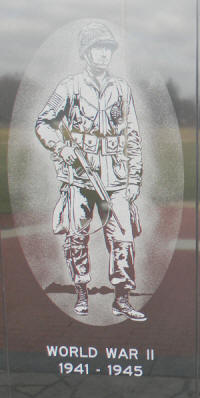 WORLD
WAR II
WORLD
WAR II
1941 - 1945
Cause: There are numerous reasons why World War II began. Among the more important ones ranks a desire for Germany to reclaim land seized from it following the German defeat in World War I. Germany, Italy and Japan also helped their people cope with the Great Depression by building up their respective militaries. Jobs opened in defense plants, as these nations expanded their militaries. Other men found jobs in the armed forces of these nations. As these nations became militarily stronger, nationalism and a general desire to be the most powerful country on the earth prompted them to expand.
At the beginning of World War II, The United States was not an active participant. At the same time, Americans were preparing for the possibility of war. The U.S. government actively assisted Great Britain in Europe against Germany by lending or leasing the British military equipment and trading the British fifty U.S. destroyers for approximately one dozen British military bases around the world.
Japan was able to expand its control in Asia and in the rest of the Pacific. The Japanese were concerned about the United States’ strength and the potential for American involvement in the war. As a result, Japanese military leaders, led by Admiral Isoroku Yamamoto, planned a preemptive attack on The United States naval base at Pearl Harbor, the home port for the U.S. Pacific Fleet. They hoped to significantly weaken the U.S. Pacific Fleet and prolong American entry into the war.
The Japanese attack took place on December 7, 1941. The Americans were totally surprised by the attack, suffering high casualties. By the time that the attack was over, 2,390 Americans had lost their lives. Three American battleships, the USS Arizona, the USS Utah and the USS Oklahoma, were totally destroyed. The other American ships also saw heavy damage but were later repaired and returned to duty. The Japanese also destroyed many American aircraft located at nearby airfields.
The Conclusion: By July 1945, scientists had developed three atomic bombs. After a successful test of the first bomb near Alamogordo, New Mexico, on July 16, 1945, President Truman authorized The United States military to utilize another atomic bomb against Japan. On August 6, 1945, the crew of the Enola Gay, which was piloted by Ohioan Paul Tibbets, dropped an atomic bomb on Hiroshima, Japan. Approximately 200,000 people died. This atomic bomb, nicknamed Little Boy, along with a second atomic bomb, dropped on Nagasaki, Japan, on August 9, 1045, prompted the Japanese government to surrender.
| Ohioans Served: |
839,000 |
| Ohioans Died: |
23,000 |